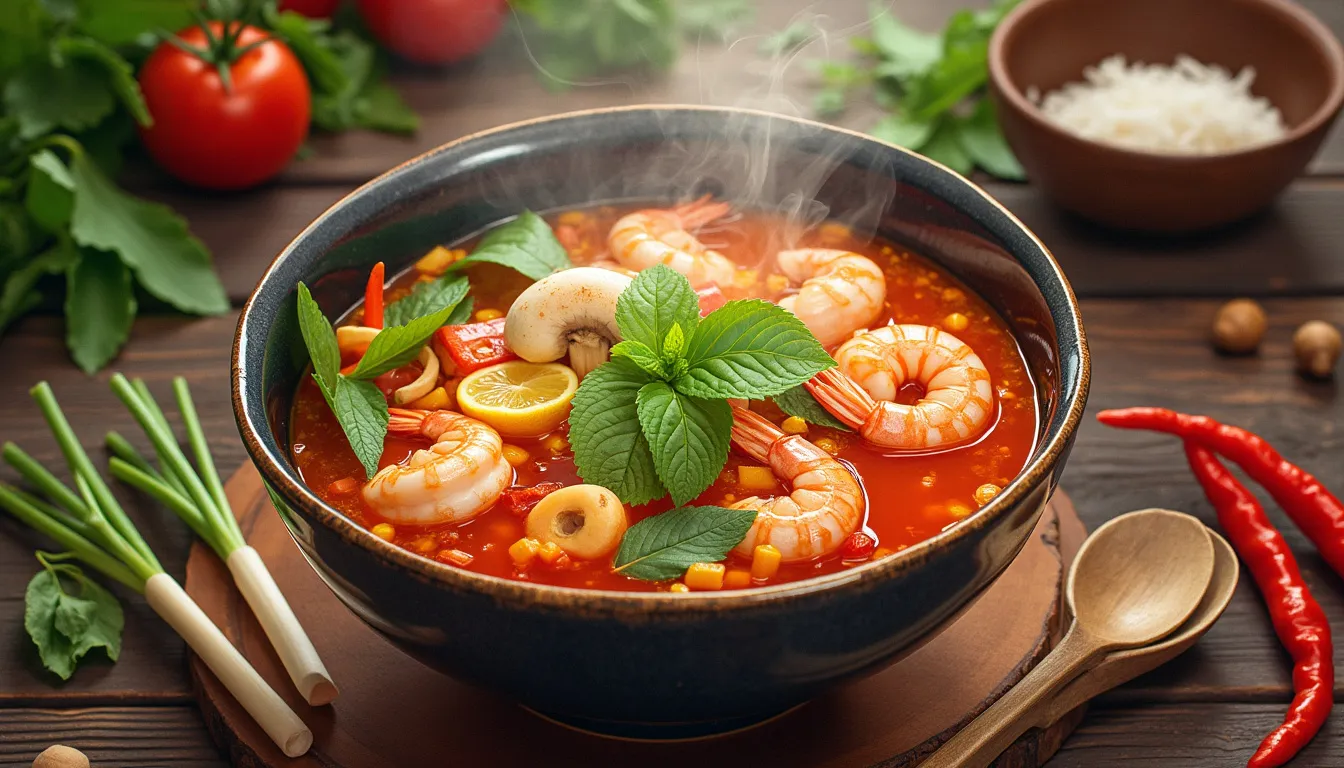Tom Yum broth, a staple of Thai cuisine, has captivated food lovers around the world with its audacious blend of sour, spicy, salty, and savory flavors. Originating from Thailand, this beloved soup is not just a dish but a reflection of the country’s rich culinary heritage and cultural significance. Each spoonful of Tom Yum broth tells a story of tradition, craftsmanship, and deeply ingrained culinary practices that have been passed down through generations. Central to its irresistible taste are the essential ingredients like lemongrass, kaffir lime leaves, galangal, and Thai chilies, each adding its unique contribution to the broth’s complex flavor profile.
The authentic taste of Tom Yum broth is further enhanced by the inclusion of other fresh ingredients such as shrimp, mushrooms, tomatoes, and fresh herbs. Together, they create a harmonious explosion of flavors that is both bold and nuanced. Cooking techniques for Tom Yum broth vary from traditional methods, which rely on simmering fresh ingredients to release their aromatic qualities, to modern twists that leverage contemporary culinary innovations. Whether you favor the classic Tom Yum Goong (shrimp) or adventurous regional variants that feature different proteins and vegetables, there’s a version of Tom Yum broth to tantalize every palate.
In exploring the diverse world of Tom Yum broth, one discovers not just a vibrant and zestful soup but a culinary experience that epitomizes the essence of Thai gastronomy. With its robust flavors and versatile recipe variations, Tom Yum broth continues to evolve, inspiring chefs and food enthusiasts around the globe.
Introduction to Tom Yum Broth
Origin and Cultural Significance
Tom Yum Broth, one of Thailand’s most beloved culinary treasures, is a dish that embodies the bold and vibrant flavors of Thai cuisine. The origins of Tom Yum can be traced back to central Thailand, where the abundance of fresh herbs and spices gave rise to this flavorful, aromatic broth. Tom refers to boiling, while Yum denotes the combination of hot and sour flavors, creating a broth that is both invigorating and delightfully complex.
Rich with cultural significance, Tom Yum Broth has become a symbol of Thai hospitality and culinary heritage. It is commonly enjoyed in Thai households as a comforting and nutritious soup, often served as a starter or a hearty main dish. The broth’s appeal has transcended borders, making its way into Thai restaurants worldwide, where it continues to captivate the taste buds of food enthusiasts.
Essential Ingredients and Their Unique Contributions
The magic of Tom Yum Broth lies in its harmony of essential ingredients, each contributing a unique element to the overall flavor profile. Here is a breakdown of these key components:
Lemongrass
Lemongrass is indispensable in Tom Yum Broth, imparting a citrusy and slightly sweet aroma that permeates the soup. Its fibrous stalks are usually bruised or cut into sections to release their essential oils, infusing the broth with a zesty, lemony scent that defines this classic Thai soup.
Kaffir Lime Leaves
Kaffir lime leaves add an unparalleled tangy freshness to the broth. Typically torn or shredded to release their oils, these leaves enhance the soup’s complexity with their unique citrus notes. The aromatic quality of kaffir lime leaves elevates Tom Yum Broth to an experience that is both refreshing and intricate.
Galangal
Often confused with ginger, galangal is a root that contributes a peppery, pine-like flavor to the broth. Its robust and peppery undertones distinguish Tom Yum Broth from other soups. Sliced into thin rounds, galangal’s earthy notes meld beautifully with the other ingredients, adding depth and warmth.
Chilies
Chilies are the heat source in Tom Yum Broth, bringing a spicy kick that balances the sour and salty elements. Thai bird’s eye chilies are commonly used for their potent heat and fruity flavor. Adjusting the number of chilies can vary the spice level to suit different palates, ensuring that each bowl of Tom Yum can be tailored to individual tastes.
Fish Sauce
Fish sauce provides the salty, umami backbone of Tom Yum Broth. Made from fermented fish, it adds a rich, savory depth that enhances the overall flavor complexity of the soup. Incorporating fish sauce balances the acidity and spiciness, creating a harmonious interplay of tastes.
Tamarind
Tamarind plays a crucial role in contributing the signature sourness to Tom Yum Broth. The pulp or paste of tamarind is dissolved into the soup, which provides a tangy and slightly sweet undertone. This sour element is vital in achieving the perfect Yum balance in this delicious dish.
Lime Juice
Fresh lime juice is typically added towards the end of cooking to preserve its bright and tart flavor. Lime juice enhances the broth’s acidity, complementing the spicy and salty components to create the quintessential hot and sour profile. Its freshness is a refreshing counterpoint to the bold, rich flavors.
Mushrooms
Mushrooms, often straw mushrooms or oyster mushrooms, lend a meaty texture and earthy flavor to Tom Yum Broth. They soak up the aromatic broth, becoming little flavor bombs within the soup. Their inclusion not only adds nutritional value but also enhances the overall mouthfeel.
Tiger Prawns
Tiger prawns are a popular protein choice for many variations of Tom Yum. Their sweet, succulent taste pairs perfectly with the spicy, sour broth, creating a sumptuous and satisfying soup. The prawns’ firm texture provides a delightful contrast against the tender vegetables and herbs in the soup.
Overall, the combination of these essential ingredients in Tom Yum Broth results in a dynamic and exhilarating dish. Each component not only brings its own unique flavor but also interacts with the others to create a symphony of tastes that make Tom Yum Broth a distinctive, must-try experience. Whether you’re tasting it for the first time or savoring it as a familiar favorite, Tom Yum Broth remains a testament to the bold flavors and culinary artistry of Thai cuisine.

Cooking Techniques and Recipe Variations
Traditional Methods vs. Modern Twists
Tom Yum broth has evolved considerably over the years, blending traditional methods with contemporary culinary innovations. The classic approach to making Tom Yum broth involves simmering a medley of ingredients that collectively imbue the broth with its signature hot and sour flavors. Essential components like lemongrass, galangal, kaffir lime leaves, and fresh chilies are traditionally used to create a base that is both aromatic and undeniably potent.
In traditional recipes, these ingredients are usually added to the simmering water in stages, ensuring that each layer of flavor is fully extracted. Protein elements such as shrimp or chicken are often added later in the cooking process to prevent overcooking. The definitive touch of fish sauce, which adds a burst of umami, and a squeeze of lime juice just before serving, brings the dish to life.
However, modern culinary techniques have introduced fascinating twists to the traditional Tom Yum broth. For instance, some chefs use pressure cookers to expedite the flavor extraction process, significantly reducing cooking time while preserving the broth’s complex character. There are also creative incorporations of sous-vide cooking, which allows for precise temperature control, enhancing the infusion of the broth’s core ingredients.
Another popular modern twist includes the use of unconventional proteins like tofu or tempeh, making the dish accessible to vegetarian and vegan diets. The incorporation of premium ingredients such as lobster or crab in place of shrimp has elevated the dish to gourmet levels, catering to high-end culinary experiences.
Popular Variants and Regional Differences
While the basic essence of Tom Yum broth remains consistent, various regional differences and popular variants have contributed to its rich diversity. One of the most renowned variants is Tom Yum Goong, where ‘Goong’ translates to shrimp. This version emphasizes shrimp as the primary protein, boasting a clear and spicy broth distinctly characteristic of central Thai cuisine.
Conversely, Tom Yum Nam Sai features a clear broth, devoid of the coconut milk or evaporated milk that some modern versions might include. This variant emphasizes a sharper, more pungent flavor profile, often enhanced by a robust chili paste called ‘Nam Prik Pao.’ The clear broth allows for a lighter, more refreshing experience, often preferred in hotter climates.
Tom Yum Nam Khon, on the other hand, presents a creamy alternative. By incorporating coconut milk or evaporated milk, this version softens the broth’s sharp edges, lending a richer, milder profile. Popular in regions such as Northeastern Thailand, this variant has found a global presence due to its balanced flavor that appeals to those who prefer a creamier texture.
Beyond these established versions, local adaptations have led to numerous eclectic variants. In some coastal areas, fresh seafood like fish, squid, and mussels are frequently used, creating a Tom Yum Talay or seafood Tom Yum. This regional dish capitalizes on the fresh marine offerings available, producing a broth with distinct oceanic nuances.
Evolving culinary trends have also given rise to fusion versions of Tom Yum broth. Inspired by different cuisines, interactions between Thai flavors and other culinary traditions have birthed hybrid dishes. For example, Tom Yum ramen combines the spicy broth with traditional Japanese ramen noodles, offering a delightful mash-up of flavors and textures that have become popular in Asian fusion restaurants worldwide.
Moreover, the influence of Tom Yum broth has extended far beyond Thailand with international adaptations reflecting local tastes. In Australia, for instance, various restaurants serve ‘Down Under Tom Yum,’ featuring local ingredients like lemon myrtle as a substitute for traditional lime leaves, creating a uniquely Aussie twist on the classic dish.
As the culinary world continues to innovate, new variants, techniques, and creative fusion dishes centered around Tom Yum broth are bound to emerge, keeping this timeless dish dynamic and ever-evolving. Whether you adhere to traditional recipes or venture into modern interpretations, the exquisite flavors of Tom Yum broth promise an extraordinary gastronomic journey.
In conclusion, Tom Yum broth is a remarkable testament to the rich culinary heritage of Thailand, exemplifying the country’s flair for blending diverse and bold flavors. This vibrant soup is more than just a dish; it’s a cultural icon with a history deeply intertwined with Thai traditions and a reflection of the nation’s love for fresh, aromatic, and intensely flavorful ingredients. The essential components of Tom Yum, such as lemongrass, kaffir lime leaves, galangal, and Thai chilies, each contribute to its complex, signature taste profile that balances sour, spicy, and savory notes with elegance and precision.
Exploring the various cooking techniques and recipe variations reveals the adaptability and timeless appeal of Tom Yum broth. While traditional preparation methods preserve the authenticity and time-honored practices passed down through generations, modern twists and innovative versions showcase the creative potential of the dish, catering to evolving palates and dietary preferences. Popular variants like Tom Yum Goong (with shrimp) and Tom Yum Gai (with chicken) further highlight regional influences and the versatility of this beloved soup.
Ultimately, the enduring allure of Tom Yum broth lies in its ability to evoke a sensory journey that transports the diner to the bustling streets and tranquil kitchens of Thailand. Whether enjoyed in its classic form or through contemporary renditions, Tom Yum remains a soulful and invigorating experience that continues to captivate and inspire food enthusiasts around the world.







